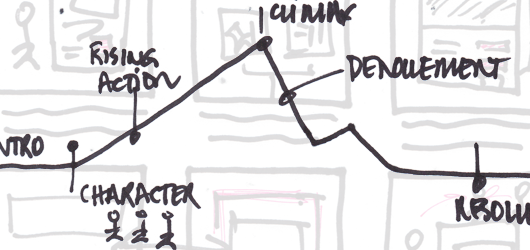I wanted to share a recent article I wrote that’s been published on UX Magazine’s website, it’s called Owning Your Story. Storytelling has been on my mind a lot recently. But not in the way that everyone’s talking about. It’s not about the basics of how to tell a story. Continue reading
Kill The Content, Tell Your Stories
Content is a popular topic right now. Brands are heavily focused on how to create, distribute, and measure their content – with the belief that content will lead to customers.
It’s true, the distribution channels that brands have access to put them closer to the consumer than ever before. And, the time that people spend online is higher than it’s ever been – and with smartphones, people are always just a tap or swipe away from these channels. In short, the opportunity appears to be huge to connect consumers with branded content. But, is this really the case?
Mitch Joel of Twist Image wrote a great article called The Drug Of Content that focuses on the misconception we have about the need for content and the value that it can have. Joel outlines a few key problems. First, it asks a lot of consumers. Messages pass by consumers as fast as cars on a freeway. How can you be sure that your consumers (or future consumers) will even notice? Second, the speed at which content can be distributed risks that we focus on the quantity of content we can produce and therefore, the quality suffers. So what’s a brand to do? Continue reading
What User Experience Designers Can Learn From Filmmakers
Lately I’ve been thinking about the lessons that user experience designers can learn from filmmakers.
When I first started researching this concept, I thought that the key discovery would be related to storytelling. I thought that there would be an undiscovered process or method that we could take from film and apply to products. But, turns out, that’s not it. I think the greatest lesson we can take from filmmaking is not the art of story – but the art of decision making and the role of the director.
One of the greatest challenges in any project is to maintain that precious momentum forward (and hopefully, upward). Without continuous progress, you aren’t learning anything, and a huge amount of our time is spent Continue reading
Why We Need Product Storytellers At The Heart Of Product & Technology
Update: This post received a lot of great feedback and was re-written in more detail as an article for UX Magazine.
I am not a designer.
The word ‘design’ is far too limiting. What I really do is tell stories. I ask questions, find answers, and figure out how to distill a vision and idea into a product story.
There’s a lot of talk right now in the start up world about creating a founding team and whether a founder should hire technical or product first. The answer is more than obvious.
Technology is a means by which the product is brought to life.
But, without a story for the product, the rest of the team doesn’t don’t know what to build, sell, and evangelize. I’ve seen this happen over and over.
A founder has an idea and hires a team, but often doesn’t have strong product perspective on that team. Then, someone like me comes in, talks to the founder, and synthesizes the vision into a story and prototype, leading to the realization that what the founder envisioned is not what’s being created.
A founder has the vision. A founder provides the starting point. A founder has the initial idea … but a product is more than an idea. A product is more than a website. A product is more than a transaction. A product creates a relationship that produces an experience that brings added value to someone’s life.
In the article The Science of Relationships, I asked the question:
“How can we transform advertising from a series of static touchpoints with a brand to a dynamic network of thoughtfully designed interactions that are tailored to and seamlessly blend with people’s lifestyles – creating a strong brand connection – a lifelong marriage with the brand.”
We need to start thinking about products as relationships. Every company needs a product story that clearly outlines how a relationship will be created and sustained with every person that engages in the product. Part matchmaker, part marketer, part technologist, part artist, part strategist … the product storyteller liaises between all areas of an organization to ensure to that everything being created is helping to strengthen the relationship that the product has with the consumer.
Today we are feeling the effects of not having enough product storytellers. This hinges on the fact that too many people who call themselves designers lack the fundamental skill of storytelling. Before you can communicate anything visually, you have to establish the story that your visualization or experience is going to tell.
To every designer, you need to become a better product storyteller. You need to stop focusing on the pixels and think about the plot, the people, and the product. Write more. Ask questions. Become an expert in relationships.
To every technologist, I respect you. I also know enough of you to know that you feel the frustration and often have to do things over and over due to an unfocused product vision. So please understand that in saying that product should come first, I do this so that when you embark on creating a product, the vision is established and you can focus on creating great technology, not deciphering a disconnected vision.
To every founder, never stop having ideas. It’s because of people like you that new amazing products are brought to market. But, in a society where attention spans keep getting shorter and shorter, please realize that it is the product that establishes the strongest relationships that will win. So before you do anything else, establish your product’s story.
Update # 1:
This post received a lot of great feedback and was re-written in more detail as an article for UX Magazine.
Update # 2:
I’ve been asked to speak on the idea of product storytelling a few times. Here are the slides from one of my talks:



